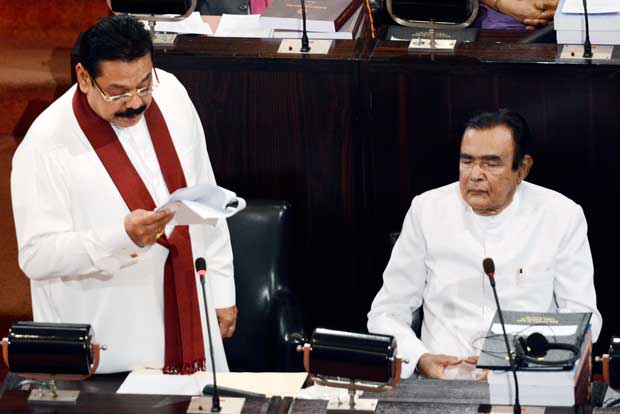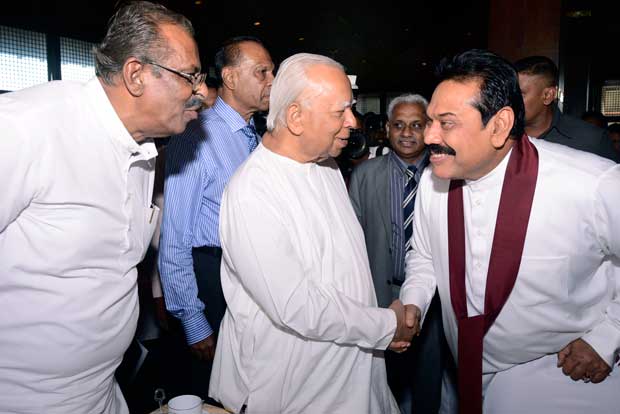Reply To:
Name - Reply Comment
.jpg)
.jpg)
On Friday, after reading the budget 2015, President MahindaRajapaksa turned towards the Opposition and asked: “Kohomada baiyange budget eka,” (How is bumpkin’s budget?). He was taking a swipe at his upper-middle class critics who think he is a baiya, who implements his medamulana thinking on a national scale while those in the West consider him a populist despot, who turned Asia’s oldest democracy into his fiefdom. They are not wrong. Some of Rajapaksa policies mirror their perceptions. However, they are wrong at least on one count. They have continually refused to acknowledge Rajapaksa’s economic achievements. By their refusal, they have prompted concerns (not so much about Rajapaksa) but about the sincerity of their own intentions.

The budget delivered last week was one such case. Though it was clearly an election budget, which had significant giveaways, it should alsobe acknowledged for what it did not give away. The budget raised public sector salaries by nearly one fifth, increased “Mahapola” scholarships to Rs.4,000, the employer’s contribution to the EPF to 14 per cent, introduced allowance for the differently-abled, teachers and financed a nationwide free health check-up. At the same time, the economy is expected to grow at 8 per cent next year, up from 7.8 this year and the budget deficit would be down to 4.6 per cent from 5 per cent this year.
What Rajapaksa did not giveaway was crippling subsidies, ranging from flour to fuel and bloated welfare schemes, including Janasawiya and Samurdhi, that besotted the Sri Lankan economy. None of those programmes created wealth or opportunities for the poor, instead they funneled vast amount of public funds that could have been invested in social and physical infrastructure (which, in fact, create opportunities) to programmes that were meant to buy the votes of the poor. Instead Rajapaksa’s ‘populist budget’ is aimed at creating opportunities – when it offers 50,000 scholarships for kids from poor families to go to universities or increase Mahapola or Grade-five scholarships by a meaningful amount or cut down electricity tariff for small business.
However, his challenge would be to increase the efficiency and productivity in the bloated 1.3 million public sector, failing which his entire development agenda would be compromised.
Nonetheless this is not a review on the budget, but, rather an unusual eulogy of Rajapaksa’s handling of the economy, which despite the lack of transparency, allegations of graft and nepotism, is still the best Sri Lanka has had since the independence.

The only other president, J R Jayawardene liberalized the economy and implemented some of the large scale infrastructure development projects, especially theMahaweli scheme, however, after a momentary spark in the immediate aftermath, the economic growth rate plummeted due to social unrest and two insurgencies, that Jayawardene’s policies themselves were responsible for creating. The average economic growth rate of Jayawardene’s presidency was a dismal 4 per cent -- though still better than the meager 2.5 per cent recorded bySirima Bandaranaike regime from 1970-77. None of Jayewardene’s successors, until the election of Rajapaksa, had a long- term economic vision.
R. Premadasa may have been an exception, but his tenure was cut short and he reigned over an island wide carnage of tyre pyres and 60,000 deaths; an extreme level of violence that even the worst pro- growth authoritarian regimes did not dare to venture into. (Some did, in fact, in the 60s, such as Suharto’s crack down on communists, but, such level of unrestrained violence was few and far between in the latter half of the 80s)
MahindaRajapaksa during his nine years in the office has ended a civil war that began in Jayawardene’s presidency and presided over an economy that grew at a healthy 7 per cent (and it expanded toan average 6 per cent during the three years, he waged a full scale war against the LTTE). He has embarked on the most ambitious infrastructure development programme in Sri Lankan history and forced Sri Lanka to dream big for the first time. Those development projects, ranging from expressways, ports, private universities, slum relocation and even casinos (which have now been levied a 10 per cent gaming revenue tax and a US$100 entrance fee) would have enormous economic multipliers and propelled the economy as Sri Lanka is heading towards middle income status.
And what is also interesting is that only Rajapaksa could implement some of those projects for it is he and his fellow travellers in the SLFP and the JVP who regularly took to the streets against some of the earlier economic projects, scuttling some, and delaying many, such as the coal power plant which was initially proposed to be set up in Trincomalee and private medical university in Ragama, both in the late 80s. Some of the recent projects such as slum relocation and relocation of street hawkers into designated areas would not have succeeded without a significant political will. Rajapaksa has shown that will for a transformative economic policy.
Of course, his government is plagued by lack of transparency, corruption and nepotism. A sizeable portion of public money has been siphoned off. One economist with inside knowledge tells me that the government pays 30 per cent more than the market average for large scale infrastructure projects. That is however partly due to the loan conditions of such projects, many of which are funded by China which requiresthe lender to choose contractors.
The Rajapaksa regime reminds me of the previous pro-growth authoritarian regimes in East Asia and South East Asia and also Chile. From South Korea to Indonesia to Malaysia those regimes were corrupt and nepotistic. Rulers, their families and inner circles served themselves with state tenders and public funds, which ended in their offshore bank accounts. But, they were also reasonably good economic managers as well and reigned over economies that grew at healthy growth rates and had long term economic visions.
Rajapaksa shares more similarities with the leaders of pro-growth authoritarianism than his elected counterparts. Rwanda’s Paul Kagame who is touted for his economic management and at the same time decried for the crackdown ondissent is another present day counterpart of Rajapaksa.
However, there again, Rajapaksa is an elected leader in a truly multiparty electoral system whereas his predecessors in pro-growth authoritarianism were unelected dictators. However, like them, Rajapaksa has reduced the legislature and other independent institutions to a rubber stamp. Should he decide to reinstate those institutions, he would derive more legitimacy in the eyes of his international counterparts. Those institutions would also have a moderating impact on some of the evils of his government.
However, from Chile to Indonesia, the dictators of previous decades had none of them. Still, their economies grew (though Indonesia’s crashed with the Asian economic crisis) while the leaders also got richer.
What is also interesting is that at one point of evolution, structures that were created by those leaders found that their leaders are disposable. Though Mahathir resigned on his own, Suharto was ousted. Both Suharto and Pinochet faced legal action against excesses of power during their regimes and evaded justice due to old age. To reach that point and to manage the economies in the absence of their patriarchs thereafter, countries should achieve a degree of economic and democratic maturity. That is a process that takes time.
Sri Lanka at its $3280 per capita GDPis lagging far behind. At this stage of development, it is likely to benefit fromRajapaksa’s pro-growth authoritarianism than a benign but ineffective democratic leader. This may not be the ideal situation. But, miserable situations call for less perfect solutions. People need money as much as they need democracy.
To disrupt this process before it reaches a point where he is no longer needed is not in the best interest of the country. When we reach that point, whether he leaves power like a Mahathir or a Suharto is a different question.